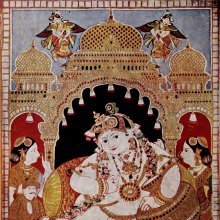Navanita, Navanīta, Navanītā, Nāvanīta, Nava-nita: 22 definitions
Introduction:
Navanita means something in Hinduism, Sanskrit, Jainism, Prakrit, Buddhism, Pali, Marathi. If you want to know the exact meaning, history, etymology or English translation of this term then check out the descriptions on this page. Add your comment or reference to a book if you want to contribute to this summary article.
Images (photo gallery)
In Hinduism
Ayurveda (science of life)
Rasashastra (Alchemy and Herbo-Mineral preparations)
Source: Wisdom Library: Rasa-śāstraNavanītā (नवनीता):—One of the sixty-four Divyauṣadhi, which are powerful drugs for solidifying mercury (rasa), according to Rasaprakāśa-sudhākara (chapter 9).
Dietetics and Culinary Art (such as household cooking)
Source: Shodhganga: Dietetics and culinary art in ancient and medieval IndiaNavanīta (नवनीत) refers to the “fresh butter”, and is commonly found in literature dealing with the topics of dietetics and culinary art, also known as Pākaśāstra or Pākakalā.—Curds was widely used in Vedic period. Ṛgveda mentions a preparation in which the curds were mixed with Soma juice and barley meal. [...] According to Om Prakash, the cream of milk (santānikā), the cream of curds (sara), whey (mastu), fresh butter (navanīta), clarified butter (ghṛta) and the butter milk (takra) are all referred to in Ayurvedic preparations. Curds churned without water (ghola) is referred to in Suśrutasaṃhitā.
Later in the classical literature we can see that fresh butter (navanīta), butter prepared from the previous day’s milk (haiyaṅgavīna) and clarified butter (ghṛta) were widely referred to in. Clarified butter was considered a germicide in Matsyapurāṇa.
Toxicology (Study and Treatment of poison)
Source: Shodhganga: Kasyapa Samhita—Text on Visha ChikitsaNavanīta (नवनीत) or “butter” is used in the treatment of snake-bites such as those caused by the Uṣṇa, Śopha, Pītta or Ghoṇasa varietes of Maṇḍalī-snakes, according to the Kāśyapa Saṃhitā: an ancient Sanskrit text from the Pāñcarātra tradition dealing with both Tantra and Viṣacikitsā—an important topic from Āyurveda which deals with the study of Toxicology (Viṣavidyā or Sarpavidyā).—Accordingly, the treatment is mentioned as follows: “A drink prepared from butter (navanīta), curd, salt, honey and Kaṭutraya is the generic treatment for Maṇḍalī snakes. Cooked Kadamba mixed with ghee and water must be consumed. White sesame also helps in alleviating this poison. Paste made out of ginger, pepper, long pepper, and salt in equal measures mixed with butter , when applied , forms an efficacious antidote”.
Unclassified Ayurveda definitions
Source: archive.org: Vagbhata’s Ashtanga Hridaya Samhita (first 5 chapters)Navanīta (नवनीत) refers to “fresh butter”, as mentioned in verse 5.35-36 of the Aṣṭāṅgahṛdayasaṃhitā (Sūtrasthāna) by Vāgbhaṭa.—Accordingly, “[...] fresh butter [viz., navanīta] of the same day (is) viriligenio, cooling, productive of colour, strength, and digestion, constipating, (and) destructive of wind, hemorrhage, consumption, hemorrhoids, hemiplegia of the face, and cough; [...]”.

Āyurveda (आयुर्वेद, ayurveda) is a branch of Indian science dealing with medicine, herbalism, taxology, anatomy, surgery, alchemy and related topics. Traditional practice of Āyurveda in ancient India dates back to at least the first millenium BC. Literature is commonly written in Sanskrit using various poetic metres.
Purana and Itihasa (epic history)
Source: archive.org: Shiva Purana - English TranslationNavanīta (नवनीत) or Navanītamaya refers to “butter”, representing the material of the liṅga of Devī (the Goddesses), according to the Śivapurāṇa 2.1.12, where the Devas and Viṣṇu requested Viśvakarman for liṅgas for the achievement of the desires of all people:—“[...] at our bidding Viśvakarmā made liṅgas and gave them to the devas according to their status. [...] the Goddesses (Devī) took the liṅgas of butter (Navanīta-liṅga); the Yogins took liṅgas of the ash; the Yakṣas took liṅgas of curd and the deity Chāyā took a liṅga of beaten flour. [...] Thus different kinds of liṅgas were given to them by Viśvakarmā which the devas and the celestial sages worship regularly. After giving the devas the various liṅgas from a desire for their benefit, Viṣṇu explained the mode of worship of Śiva to me, Brahmā”.

The Purana (पुराण, purāṇas) refers to Sanskrit literature preserving ancient India’s vast cultural history, including historical legends, religious ceremonies, various arts and sciences. The eighteen mahapuranas total over 400,000 shlokas (metrical couplets) and date to at least several centuries BCE.
Sports, Arts and Entertainment (wordly enjoyments)
Source: archive.org: Syainika Sastra of Rudradeva with English Translation (art)Navanīta (नवनीत) refers to “butter” (suitable for feeding one’s hawk), according to the Śyainika-śāstra: a Sanskrit treatise dealing with the divisions and benefits of Hunting and Hawking, written by Rājā Rudradeva (or Candradeva) in possibly the 13th century.—Accordingly, [while discussing the treatment of hawks]: “[...] Pans (kuṇḍika) full of water should be kept before them for bathing. If they cast their gorge, then the medicine is, powdered Methi (Trigonella foenum-graecum) with buffalo-butter (navanīta) [mahiṣyā navanītena]. [...]”.

This section covers the skills and profiencies of the Kalas (“performing arts”) and Shastras (“sciences”) involving ancient Indian traditions of sports, games, arts, entertainment, love-making and other means of wordly enjoyments. Traditionally these topics were dealt with in Sanskrit treatises explaing the philosophy and the justification of enjoying the pleasures of the senses.
In Jainism
General definition (in Jainism)
Source: archive.org: Economic Life In Ancient India (as depicted in Jain canonical literature)Navanīta (नवनीत) refers to “butter” and is one of the four products of milk (gorasa). Dairy farming was carried on in a big way in ancient India. There were large cow-sheds (gomaṇḍava or gomaṇḍapa) where the herds of cows, bulls and calves were kept. There was abundant supply of milk (dugdha or khira) and its four products (gorasa) viz. curd (dadhi), butter milk (udasi or maṭṭhā), butter (ṇavaṇiya or navanīta), clarified butter or ghee (ghṛta or ghaya). Milk and milk products were available in plenty at the dairy (dohaṇa-vāḍaga). The products were stored in ‘khira sālā’. Many articles of daily food were prepared with the help of milk and its products. People could get highly nutritious food because of the easy and large supply of the dairy products.
Source: archive.org: Jaina YogaNavanīta (नवनीत, “butter”) refers to one of the ten classifications of food (āhāra), also known as vikṛtis, according to the 12th century Yogaśāstra (verse 3.130) by Hemacandra. Navanīta may be from cow’s, buffalo’s, goat’s or sheep’s milk, but not from camel’s milk.

Jainism is an Indian religion of Dharma whose doctrine revolves around harmlessness (ahimsa) towards every living being. The two major branches (Digambara and Svetambara) of Jainism stimulate self-control (or, shramana, ‘self-reliance’) and spiritual development through a path of peace for the soul to progess to the ultimate goal.
Languages of India and abroad
Pali-English dictionary
Source: BuddhaSasana: Concise Pali-English Dictionarynavanīta : (nt.) fresh butter.
Source: Sutta: The Pali Text Society's Pali-English DictionaryNavanīta, (nt.) & nonīta (cp. Ved. navanīta) fresh butter Vin. I, 244 (cp. gorasa); D. I, 201; M. III, 141; Pv III, 55 (nonīta); Pug. 69, 70; Miln. 41, Dhs. 646, 740; DhA. I, 417; PvA. 199. (Page 348)

Pali is the language of the Tipiṭaka, which is the sacred canon of Theravāda Buddhism and contains much of the Buddha’s speech. Closeley related to Sanskrit, both languages are used interchangeably between religions.
Marathi-English dictionary
Source: DDSA: The Molesworth Marathi and English Dictionarynavanīta (नवनीत).—n (S) Fresh butter or butter gen.
Source: DDSA: The Aryabhusan school dictionary, Marathi-Englishnavanīta (नवनीत).—n Fresh butter or butter gen.
Marathi is an Indo-European language having over 70 million native speakers people in (predominantly) Maharashtra India. Marathi, like many other Indo-Aryan languages, evolved from early forms of Prakrit, which itself is a subset of Sanskrit, one of the most ancient languages of the world.
Sanskrit dictionary
Source: DDSA: The practical Sanskrit-English dictionaryNāvanīta (नावनीत).—(-tī f.)
1) Coming from butter.
2) Mild, soft, gentle; नावनीतं हि हृदयं विप्राणां शाम्य भार्गव (nāvanītaṃ hi hṛdayaṃ viprāṇāṃ śāmya bhārgava) Mahābhārata (Bombay) 5.185. 29. -n. Ghee recently prepared out of butter; नावनीतेन भुङ्क्ते इत्यचिरनिर्दग्धेनेति गम्यते (nāvanītena bhuṅkte ityaciranirdagdheneti gamyate) | ŚB. on MS.1.4.12.
--- OR ---
Navanīta (नवनीत).—fresh butter; अहो नवनीतकल्पहृदय आर्यपुत्रः (aho navanītakalpahṛdaya āryaputraḥ) M.3. दुग्धोत्थं नवनीतं तु चक्षुष्यं रक्तपित्तनुत् (dugdhotthaṃ navanītaṃ tu cakṣuṣyaṃ raktapittanut) Āyurveda. °धेनुः (dhenuḥ) A cow made of butter, fit to be offered to a Brahmaṇa.
Derivable forms: navanītam (नवनीतम्).
Navanīta is a Sanskrit compound consisting of the terms nava and nīta (नीत).
Source: Cologne Digital Sanskrit Dictionaries: Shabda-Sagara Sanskrit-English DictionaryNavanīta (नवनीत).—n.
(-taṃ) Fresh butter. E. nava new, and nīta procured from milk, &c.)
Source: Cologne Digital Sanskrit Dictionaries: Benfey Sanskrit-English DictionaryNavanīta (नवनीत).—[nava-nīta], n. Fresh butter, [Rāmāyaṇa] 5, 12, 27.
--- OR ---
Nāvanīta (नावनीत).—i. e. navanīta + a, adj. Mild,
Nāvanīta (नावनीत).—[feminine] ī coming from or being like butter; soft, meek.
Source: Cologne Digital Sanskrit Dictionaries: Monier-Williams Sanskrit-English Dictionary1) Navanīta (नवनीत):—[=nava-nīta] [from nava] n. (nava-) fresh butter, [Brāhmaṇa; Mahābhārata; Suśruta] etc.
2) Nāvanīta (नावनीत):—mf(ī)n. ([from] nava-nīta) coming from butter, [Nyāyamālā-vistara]
3) mild as b°, [Mahābhārata]
Source: Cologne Digital Sanskrit Dictionaries: Yates Sanskrit-English DictionaryNavanīta (नवनीत):—[nava-nīta] (taṃ) 1. n. Idem.
Source: DDSA: Paia-sadda-mahannavo; a comprehensive Prakrit Hindi dictionary (S)Navanīta (नवनीत) in the Sanskrit language is related to the Prakrit word: Ṇavaṇīa.
[Sanskrit to German]
Sanskrit, also spelled संस्कृतम् (saṃskṛtam), is an ancient language of India commonly seen as the grandmother of the Indo-European language family (even English!). Closely allied with Prakrit and Pali, Sanskrit is more exhaustive in both grammar and terms and has the most extensive collection of literature in the world, greatly surpassing its sister-languages Greek and Latin.
Kannada-English dictionary
Source: Alar: Kannada-English corpusNavanīta (ನವನೀತ):—
1) [noun] fresh butter got by churning curds.
2) [noun] (mus.) the fortieth of the seventy two main modes in Karnāṭaka system.
Kannada is a Dravidian language (as opposed to the Indo-European language family) mainly spoken in the southwestern region of India.
See also (Relevant definitions)
Starts with (+3): Navanita kavi, Navanitabandha, Navanitadhenu, Navanitadi, Navanitaganapati, Navanitaja, Navanitajataka, Navanitaka, Navanitakam, Navanitakavi, Navanitakhoti, Navanitalinga, Navanitam, Navanitamaya, Navanitamayalinga, Navanitanibandha, Navanitapani, Navanitapinda, Navanitaprishni, Navanitapriyashtaka.
Ends with: Abhinayanavanita, Acaranavanita, Adhyatmanavanita, Advaitanavanita, Arcananavanita, Arishtanavanita, Chandonavanita, Chhandonavanita, Kavyanavanita, Nibandhanavanita, Prathamanavanita, Rahasyanavanita, Rishtanavanita, Samudranavanita, Sanavanita, Tarkanavanita, Tattvanavanita, Vaikhanasarcananavanita, Vishishtadvaitanavanita.
Full-text (+44): Samudranavanita, Navanitadhenu, Navani, Navanitamaya, Navanitaka, Navanitanibandha, Navanitajataka, Navanitakhoti, Navanitasama, Navanitakavi, Navanitapinda, Navanitaprishni, Navanitaja, Navanitaganapati, Vaikhanasarcananavanita, Nibandhanavanita, Nita, Nonita, Ghrita, Navania.
Relevant text
Search found 28 books and stories containing Navanita, Navanīta, Navanītā, Nāvanīta, Nava-nita, Nava-nīta; (plurals include: Navanitas, Navanītas, Navanītās, Nāvanītas, nitas, nītas). You can also click to the full overview containing English textual excerpts. Below are direct links for the most relevant articles:
Garga Samhita (English) (by Danavir Goswami)
Verse 1.17.17 < [Chapter 17 - Description of the Yogurt Theft]
Verse 1.17.19 < [Chapter 17 - Description of the Yogurt Theft]
Verse 1.17.20 < [Chapter 17 - Description of the Yogurt Theft]
Bhesajjakkhandhaka (Chapter on Medicine) (by Hin-tak Sik)
Seven-day Medicines (a): Lipids and Sweets < [Chapter 4 - Medicinal Substances in the Chapter on Medicine]
Internal Medicine (a): Autumnal Disease < [Chapter 5 - Diseases and Treatments in the Chapter on Medicine]
Sahitya-kaumudi by Baladeva Vidyabhushana (by Gaurapada Dāsa)
Text 9.26 < [Chapter 9 - Ornaments of Sound]
Text 10.113 < [Chapter 10 - Ornaments of Meaning]
Śrī Kṛṣṇa Aṣṭottara-śata Nāmavaḷḷiḥ
Brihad Bhagavatamrita (commentary) (by Śrī Śrīmad Bhaktivedānta Nārāyana Gosvāmī Mahārāja)
Verse 1.6.52 < [Chapter 6 - Priyatama (the most beloved devotees)]
Verse 1.7.37-38 < [Chapter 7 - Pūrṇa (pinnacle of excellent devotees)]
Chaitanya Bhagavata (by Bhumipati Dāsa)
Verse 2.167 < [Chapter 2 - The Lord’s Manifestation at the House of Śrīvāsa and the Inauguration of Saṅkīrtana]
Verse 3.10.61 < [Chapter 10 - The Glories of Śrī Puṇḍarīka Vidyānidhi]
Verse 2.8.221 < [Chapter 8 - The Manifestation of Opulences]
Related products



